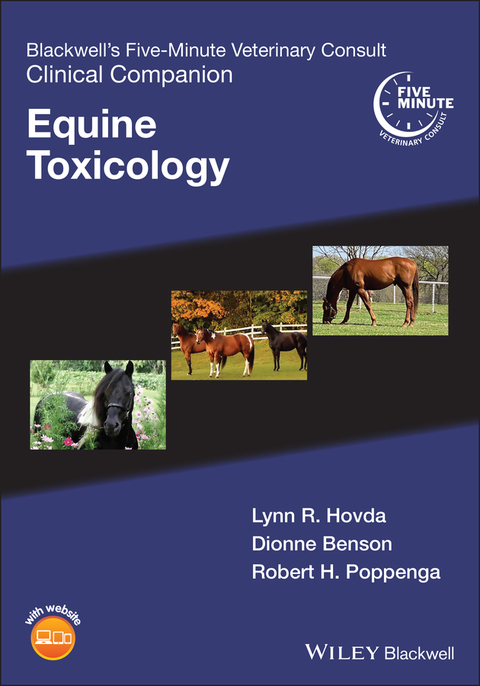
Equine Toxicology
Wiley-Blackwell (Verlag)
978-1-119-67149-7 (ISBN)
Die identisch aufgebauten Themenkapitel enthalten die wichtigsten Informationen für den Umgang mit Giftstoffen bei Pferden sowie klinische Fotoaufnahmen von Pflanzen und Wirkstoffen, um Ärzten und Studierenden bei der Erkennung von Giftstoffen zu helfen. Auf der begleitenden Website sind die Abbildungen aus dem Buch im PowerPoint-Format zum Download erhältlich.
Dieses Werk ist das ideale klinische Handbuch für die veterinärmedizinische Praxis, wenn in zeitkritischen Notfällen ein sofortiger Zugriff auf lebensrettende Informationen erforderlich ist. Die Leser erhalten auf einen Blick sämtliche Informationen, die sie für den Umgang mit Giftstoffen bei Pferden benötigen – mit farbigen Abbildungen und in einer kompakten, übersichtlichen Gliederung.
»Blackwell's Five-Minute Veterinary Consult Clinical Companion: Equine Toxicology « bietet:
- Eine umfassende Einführung in die Notfallbehandlung vergifteter Pferde und allgemeine Grundlagen zu Giftstoffen, Gegengiften, Laboruntersuchungen von Proben und zur Nekropsie
- Eine genaue Darstellung spezieller Toxine und Giftstoffe, darunter illegale und pharmazeutische Wirkstoffe, Vergiftungen, Insektizide, Herbizide und landwirtschaftliche Chemikalien
- Praktische Erörterungen der Metall-, Mykotoxin-, Rodentizid- und Pflanzentoxikologie beim Pferd
- Ausführliche Erläuterungen zur Vergiftung durch giftige Bäume und verschiedene Toxine wie Kohlenmonoxid, Nitrate, Nitrite, Salz, Rauch und tropische Hölzer
»Blackwell's Five-Minute Veterinary Consult Clinical Companion: Equine Toxicology« ist ein unverzichtbares Nachschlagewerk für Veterinärmediziner und Studierende der Pferdemedizin sowie für alle, die kompakte, umfassende Informationen über die Toxikologie beim Pferd benötigen.
Lynn R. Hovda, RPH, DVM, MS, DACVIM, is Director of Veterinary Services at SafetyCall International and Pet Poison Helpline in Minneapolis, Minnesota and Adjunct Assistant Professor in the Department of Veterinary and Biomedical Sciences at the College of Veterinary Medicine at the University of Minnesota in St. Paul, Minnesota, USA.
Dionne Benson, DVM, JD, is Chief Veterinary Officer for The Stronach Group.
Robert H. Poppenga, DVM, PhD, DABVT, is a Professor and Head of the Toxicology Section at the California Animal Health and Food Safety Laboratory System at the School of Veterinary Medicine, University of California at Davis in Davis, California, USA.
Contributors List
SECTION 1 CLINICAL TOXICOLOGY
Chapter 1 Forensic Investigation of Equine Intoxications
Chapter 2 Necropsy Analysis
Chapter 3 Laboratory Testing Considerations
Chapter 4 Treating an Intoxicated Animal: Antidotes and Therapeutic Medications
Chapter 5 Compounded Medications
SECTION 2 SPECIFIC TOXINS AND TOXICANTS
Drugs: Illicit and Recreational
Chapter 6 Cobalt
Chapter 7 Cocaine
Chapter 8 Dermorphin
Chapter 9 Growth Hormones and Secretagogues
Chapter 10 Marijuana
Chapter 11 Methamphetamine and Amphetamine
Chapter 12 Opioids
Chapter 13 Selected Androgen (SARMS) and Estrogen (SERMS) Receptor Modulators
Chapter 14 Synthetic Cannabinoids
Drugs: Prescription
Chapter 15 Antipsychotic Agents - Reserpine and Fluphenazine
Chapter 16 Benzodiazepines
Chapter 17 Beta2 Agonists - Clenbuterol and Albuterol
Chapter 18 Bisphosphonates
Chapter 19 Gabapentin
Chapter 20 Iodine
Chapter 21 Medroxyprogesterone
Chapter 22 Methylxanthines: Caffeine, theobromine, theophylline
Chapter 23 Nonsteroidal Anti-inflammatory Drugs (NSAIDS)
Chapter 24 Thyroxine (Levothyroxine)
Chapter 25 Vitamin D (calciferol)
Insecticides, Herbicides and Farm Chemicals
Chapter 26 Amitraz
Chapter 27 Cholinesterase Inhibiting Carbamate Pesticides
Chapter 28 Cholinesterase Inhibiting Organophosphate Pesticides
Chapter 29 Fertilizers - nitrates, urea, phosphates and others
Chapter 30 Herbicides
Chapter 31 Paraquat and Diquat
Chapter 32 Pentachlorophenol (PCP)
Chapter 33 Pyrethroid and Pyrethrin Insecticides
Ionophores and Growth Promotants
Chapter 34 Ionophores
Chapter 35 Ractopamine
Chapter 36 Zilpaterol
Metals
Chapter 37 Arsenic
Chapter 38 Fluoride
Chapter 39 Iron
Chapter 40 Lead
Chapter 41 Selenium
Mycotoxins / Fungus
Chapter 42 Aflatoxins
Chapter 43 Fescue (Endophyte-infected tall fescue)
Chapter 44 Fumonisins
Chapter 45 Fusaria
Chapter 46 Slaframine
Chapter 47 Tremorgenic Mycotoxins
Other Toxins
Chapter 48 Clostridium Botulinum toxin
Chapter 49 Cyanide
Chapter 50 Sodium Chloride (Salt)
Plants and Biotoxins
Chapter 51 Alsike clover (Trifolium hybridum)
Chapter 52 Blue-Green algae (Cyanobacteria)
Chapter 53 Cardiotoxic plants
Chapter 54 Day blooming Jessamine (Cestrum spp.)
Chapter 55 Death camus (Zigadenus spp.)
Chapter 56 Hemlocks (Conium maculatum and Cicuta spp.)
Chapter 57 Hoary alyssum (Berteroa incana)
Chapter 58 Jimsonweed (Datura spp.)
Chapter 59 Kleingrass (Panicum coloratum)
Chapter 60 Lantana (Lantana camara)
Chapter 61 Locoweeds (Astragalus spp. and Oxytropis spp.)
Chapter 62 Narrow leaf milkweed (Asclepias fascicularis)
Chapter 63 Nightshades (Solanum spp.)
Chapter 64 Oleander (Nerium oleander and Cascabela thevetia)
Chapter 65 Pyrrolizidine Alkaloids
Chapter 66 Rayless goldenrod (Isocoma pluriflora)
Chapter 67 Rhododendrons
Chapter 68 Sudangrass (Sorghum spp.)
Chapter 69 Tansy ragwort (Jacobea vulgaris)
Chapter 70 White snake root (Ageratina altissima)
Chapter 71 Yellowstar thistle / Russian knapweed (Centaurea solstitialis / Acroptilon repens)
Chapter 72 Yew (Taxus spp.)
Rodenticides
Chapter 73 Anticoagulants
Chapter 74 Bromethalin
Chapter 75 Cholecalciferol
Chapter 76 Phosphides
Chapter 77 Sodium fluoroacetate (Compound 1080)
Chapter 78 Strychnine
Toxic Gases
Chapter 79 Air Contaminants - CO, NH3, H2S
Chapter 80 Smoke
Trees
Chapter 81 Black locust (Robinia pseudoacacia)
Chapter 82 Black walnut (Juglans nigra)
Chapter 83 Box elder (Acer negundo)
Chapter 84 Oak (Quercus spp.)
Chapter 85 Red maple (Acer rubrum)
Zootoxins
Chapter 86 Blister Beetles (Epicauta spp. and Pyrota spp.)
Chapter 87 Snakes - Crotalids (pit vipers)
Chapter 88 Snakes - Elapids (coral snakes)
Chapter 89 Spiders - Brown recluse spider and black widow spider
Section 3 Reference Material
Appendix 1 Abbreviations
Appendix 2 Herbicides
Appendix 3 Information Resources for Toxicology
INDEX
| Erscheinungsdatum | 26.11.2021 |
|---|---|
| Reihe/Serie | Blackwell's Five-Minute Veterinary Consult |
| Verlagsort | Hoboken |
| Sprache | englisch |
| Gewicht | 666 g |
| Einbandart | kartoniert |
| Themenwelt | Veterinärmedizin ► Pferd ► Innere Medizin |
| Schlagworte | Pferde; Veterinärmedizin |
| ISBN-10 | 1-119-67149-3 / 1119671493 |
| ISBN-13 | 978-1-119-67149-7 / 9781119671497 |
| Zustand | Neuware |
| Informationen gemäß Produktsicherheitsverordnung (GPSR) | |
| Haben Sie eine Frage zum Produkt? |
aus dem Bereich


